 Gilman Studio On-Line Lessons
Gilman Studio On-Line Lessons
Yang Style Long Form
Tai Chi Chuan
This Lesson Contains:
Movement # 49 – Hit A Tiger At Left
I like this movement a lot, yet students find it difficult for some reason. It contains some nice circular moves and is very effective as a martial movement. The opponent strikes my center with his right fist. I neutralize the strike first left, then circle right, pulling the opponent out of his root. As he tries to regain balance, I step behind him, and either strike him or trap him, and follow with a solid strike to his mid section. This is one of the most powerful strikes done with the fist.
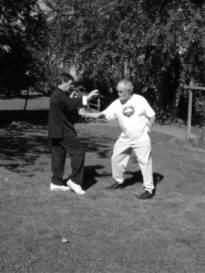 Following the foot kick, John strikes my center with his right fist.
Following the foot kick, John strikes my center with his right fist.

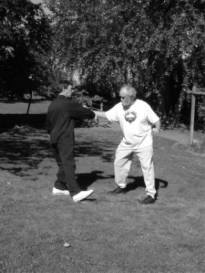 I join and neutralize the strike to the left with my right forearm.
I join and neutralize the strike to the left with my right forearm.
Step down the right heel with the toe facing slightly to the right of west. As you do this, the torso turns slightly to the left.
The right forearm drops down by pivoting the elbow. The hand is at about waist level. The left hand has dropped to end up by the left shoulder. This is almost center position.
Focus on the right forearm to join and stick.
Note: The torso turns to the left slightly as you step the foot down. This is done in order to give a smaller target in case the punch gets inside your defense. You would be moving with the punch.
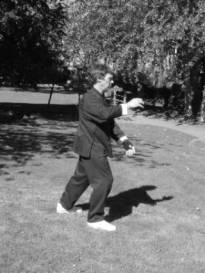
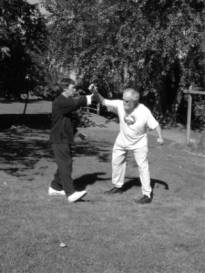 I circle John’s arm to my right, closing him up.
I circle John’s arm to my right, closing him up.
As the weight shifts onto the right foot, the torso turns to the right to end with the right toe, knee, and torso facing slightly to the right of west.
The right arm makes a clockwise circle up the center of the body then across the right shoulder to end up by the outside of the right upper chest. The palm is facing down. The left arm has dropped down, with the palm at the crotch level with the palm facing inward. The arms are basically in center position on the right.
Focus on the right forearm for sticking and leading the energy around to the right.

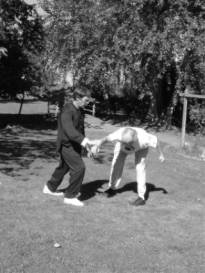 This is a very important part of the movement. At the end of the circle, I add a pull to uproot John and gather energy into my right Kua for later use.
This is a very important part of the movement. At the end of the circle, I add a pull to uproot John and gather energy into my right Kua for later use.
The arms stay in basically the same position as the body turns to the right. This is a weighted foot turn, meaning the root is still on the right foot, but as the torso turns to the right, the right toe turns to the right by pivoting on the heel. Roll up onto the left toe.
Focus on the right hand for pulling and the torso for turning.
Note: The pulling is done with the turning of the torso. It is not done just using the arm. This is the moment of possibility. I must be ready for many different possible reactions from pulling John out of his root. He might charge into me, fall down, pivot around and strike, or retreat.
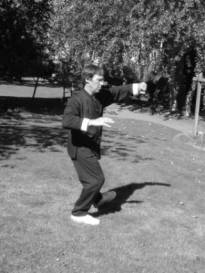
 John tries to recover his balance by moving back. I step to his right side and hook my left arm around to trap him. I could also strike him in the ear.
John tries to recover his balance by moving back. I step to his right side and hook my left arm around to trap him. I could also strike him in the ear.
Step the left foot heel ahead so the toe faces slightly to the left of west.
The right arm stays in basically the same position, while the left arm swings up clockwise to the left and makes a fist. The knuckles face inward at upper shoulder level. The left arm is quite round.
Focus on the right hand for pulling and the left fist for proper placement.
Note: It is important to keep tension on the opponent’s right arm while you get the left foot and left arm in place.

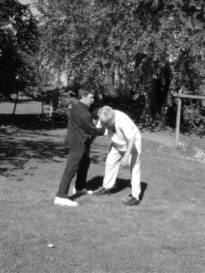 I deliver a strong strike to John’s center.
I deliver a strong strike to John’s center.
The weight is shifted onto the left foot. At the end, the toe, knee, and torso face slightly to the left of west.
This powerful strike is done entirely by the torque of the waist and the stored energy of the right Kua. The right arm stays in the same basic position by the right side of the lower chest. It moves left with the turning of the torso. The left arm remains in the same place and the body moves towards it. This movement has a strong feeling of squeezing the two arms together. The knuckles of the fists face each other. The left hand brings the opponent’s body toward the left striking fist. It is a knockout punch when done correctly.
Focus on the right fist and the left forearm.
